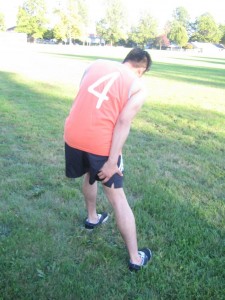The thighs are comprised of 3 sets of muscles – quadriceps at the front of the thigh, hamstrings at the rear part and adductor muscles on the interior aspect. Take note that these muscles work together in order to move and flex the thigh. Once the individual ends up with an injured thigh muscle, he/she can develop symptoms such as tightness or stiffness and even pain.
Muscle contusion
A contusion is described as an injury that develops after a direct blow and can vary in severity from mild to severe. The quadriceps muscles in the thigh are more likely to end up with a contusion which is also known as “charley horse”.
The symptoms of a contusion in the thing include tightness and pain in the area where the blow occurred along with evident swelling and bruising.
Muscle strain

The muscle strains are described as tears in the muscle tissue and most often affect the hamstring muscles. This injury is graded based on the severity where the first-degree strain as the most common which causes pain or soreness along with stiffness in the thigh. The first-degree strains tend to heal properly with home remedies such as application of ice and compression.
When it comes to second and third-degree strains, they can cause additional symptoms such as severe bruising and limping. In some cases of second-degree strains, they are managed in a similar manner with first-degree burns. In some circumstances, there is a need to consult a doctor though. In addition, the third-degree strains involve full tears of the muscle and require immediate medical attention.
What is delayed onset muscle soreness (DOMS)?
Sports or exercise that causes sore muscles is a condition called as delayed onset muscle soreness (DOMS). Other indications include tenderness, diminished muscular strength and swelling. This condition can become worse if the individual tried a new sport or exercise, exercising at high intensity or there is lack of proper warm-up.
What is compartment syndrome?
The compartments are groups of blood vessels, muscles and nerves in the arms and legs. Once pressure accumulates inside the muscles, it reduces the flow of blood and oxygen to the muscles and nerve cells.
An acute case of compartment syndrome results from an injury while chronic cases occur after exercise. The symptoms typically include pain when stretching or using the affected muscle along with cramps, burning or tingling sensation or paresthesia. In addition, acute compartment syndrome can lead to lasting tissue damage, resulting to numbness or paralysis.
Management
The remedy for tight thigh pain is based on the condition that causes it. Take note that there is no non-surgical treatment for acute compartment syndrome. On the other hand, the typical course of treatment is the RICE method (rest, ice, compression, elevation).
Once the pain diminishes, the individual should start gentle stretching. The individual must wait until the strength and flexibility returns to normal, usually within 10 days up to 3 weeks before resuming his/her usual level of exercise or activity. In case the pain does not seem to subside using home treatment after 3 weeks or persists, a doctor should be consulted.
